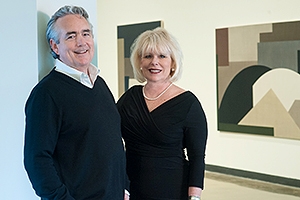Humanities
Likhachev Fellows to Explore Russian Art, Culture

Jack Rasmussen and Gail Humphries Mardirosian are two of four Likhachev Foundation Fellows from AU over the past two years.
When Jack Rasmussen, director and curator of the American University Museum, wants to organize a show featuring artists working outside the United States, it’s critical that he travel to meet the artist and see the work where it was made.
The museum’s specialty is the intersection of the international and the political, and the shows Rasmussen tends to feature represent some friction found at that intersection. Getting a feel for where the art came from is essential, Rasmussen said.
This summer, Rasmussen will have a chance to do that as one of eight Americans awarded Likhachev Foundation Fellowships. The fellows will spend two weeks in Russia exploring the culture, art, and art history of the country.
Rasmussen and Gail Humphries Mardirosian, associate professor in the Department of Performing Arts, are two of four Likhachev Fellows from AU over the past two years. Last year Anton Fedyashin, director of the Initiative for Russian Culture, and Robb Hunter, fight choreographer in residence in the Department of Performing Arts, were chosen to participate in the program.
AU has a growing relationship with Russia. In 2011, the university launched the Initiative for Russian Culture, which seeks to promote greater understanding of Russian culture among AU and Consortium students in the Washington, D.C., area.
The Likhachev fellowship is the first program of its kind organized and funded by the Russian government. When in Russia, participants work on important cultural initiatives, which help attract foreign audiences to Russian history and culture. To that end, Rasmussen will be scouting new Russian artists for shows at the museum during his two weeks in Russia.
"I want to create a dialogue. I want people to get excited," he said.
Rasmussen already has many contacts in the Russian art world, including Grisha Bruskin, a painter and sculptor from Moscow. His work, H-Hour, was on display at the AU Museum this winter along with Russian-born artist Andrei Molodkin’s exhibit CRUDE.
"I need to get on the ground and sort of work my way through the art scene there," Rasmussen said.
Rasmussen also wants to learn the role of commercial art galleries in Russia and to understand how artists are supported there. All of that is in service to the museum so he can bring the most thought-provoking and engaging shows to campus.
Mardirosian, who is trained in the Stanislavski method of acting, has long had a connection with Russia. This fellowship marks her sixth visit to the country. She sees her collaboration with Russian theater troupes as "cultural diplomacy."
"The arts and theater can unite us in ways that are really remarkable," Mardirosian said.
Mardirosian, who was recently named to the College of Fellows of the American Theatre, plans to study Russian cabarets from 1910 to 1931 during her fellowship. She’ll be working with a Russian theater and a director and choreographer to better understand the unique art form.
When she returns to the U.S., Mardirosian plans on mounting a recreation of a Russian cabaret, for which the Russian choreographer will return. Mardirosian envisions hosting a sort of literary café featuring cabaret, song, poetry, and perhaps staged readings from Russian plays.
"Cabaret allows for so much artistic expression and provocation," she said. "Russia has such a remarkably eclectic and fascinating theater work and I’m excited to see the artistic experimentation that can happen."
